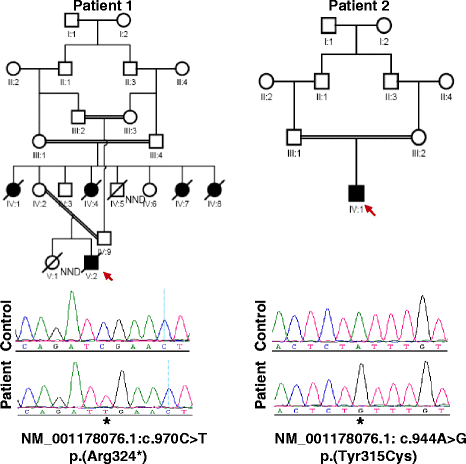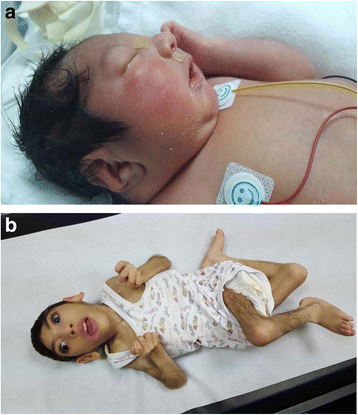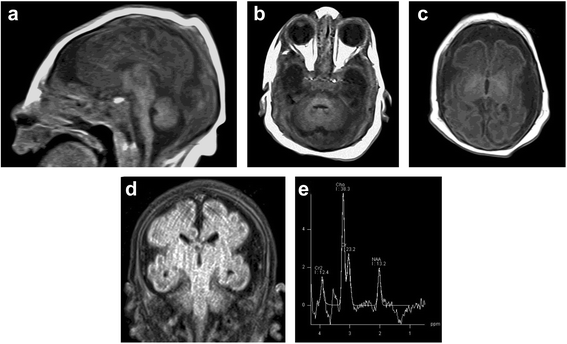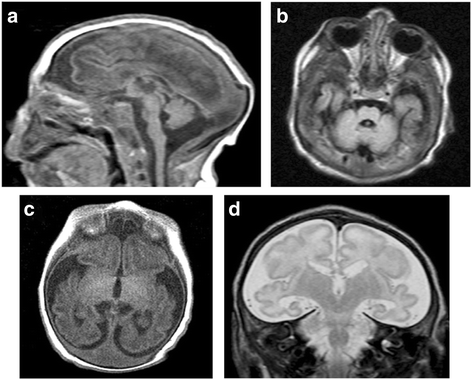Hyperekplexia, microcephaly and simplified gyral pattern caused by novel ASNS mutations, case report
- PMID: 27422383
- PMCID: PMC4947274
- DOI: 10.1186/s12883-016-0633-0
Hyperekplexia, microcephaly and simplified gyral pattern caused by novel ASNS mutations, case report
Abstract
Background: Asparagine synthetase deficiency (OMIM# 615574) is a very rare newly described neurometabolic disorder characterized by congenital microcephaly and severe global developmental delay, associated with intractable seizures or hyperekplexia. Brain MRI typically shows cerebral atrophy with simplified gyral pattern and delayed myelination. Only 12 cases have been described to date. The disease is caused by homozygous or compound heterozygous mutations in the ASNS gene on chromosome 7q21.
Case presentation: Family 1 is a multiplex consanguineous family with five affected members, while Family 2 is simplex. One affected from each family was available for detailed phenotyping. Both patients (Patients 1 and 2) presented at birth with microcephaly and severe hyperekplexia, and were found to have gross brain malformation characterized by simplified gyral pattern, and hypoplastic cerebellum and pons. EEG showed no epileptiform discharge in Patient 2 but multifocal discharges in patient 1. Patient 2 is currently four years old with severe neurodevelopmental delay, quadriplegia and cortical blindness. Whole exome sequencing (WES) revealed a novel homozygous mutation in ASNS (NM_001178076.1) in each patient (c.970C > T:p.(Arg324*) and c.944A > G:p.(Tyr315Cys)).
Conclusion: Our results expand the mutational spectrum of the recently described asparagine synthetase deficiency and show a remarkable clinical homogeneity among affected individuals, which should facilitate its recognition and molecular confirmation for pertinent and timely genetic counseling.
Keywords: ASNS gene; Arthrogryposis; Asparagine synthetase deficiency; Brain malformation; Case report; Hyperekplexia; Whole exome sequencing.
Figures




Similar articles
-
A novel compound heterozygous missense mutation in ASNS broadens the spectrum of asparagine synthetase deficiency.Mol Genet Genomic Med. 2020 Jun;8(6):e1235. doi: 10.1002/mgg3.1235. Epub 2020 Apr 7. Mol Genet Genomic Med. 2020. PMID: 32255274 Free PMC article. Review.
-
Diaphragmatic Eventration in Sisters with Asparagine Synthetase Deficiency: A Novel Homozygous ASNS Mutation and Expanded Phenotype.JIMD Rep. 2017;34:1-9. doi: 10.1007/8904_2016_3. Epub 2016 Jul 27. JIMD Rep. 2017. PMID: 27469131 Free PMC article.
-
Epileptic encephalopathy with microcephaly in a patient with asparagine synthetase deficiency: a video-EEG report.Epileptic Disord. 2019 Oct 1;21(5):466-470. doi: 10.1684/epd.2019.1100. Epileptic Disord. 2019. PMID: 31617495
-
Asparagine synthetase deficiency detected by whole exome sequencing causes congenital microcephaly, epileptic encephalopathy and psychomotor delay.Metab Brain Dis. 2015 Jun;30(3):687-94. doi: 10.1007/s11011-014-9618-0. Epub 2014 Sep 17. Metab Brain Dis. 2015. PMID: 25227173 Free PMC article.
-
A novel variant in ASNS gene responsible for syndromic intellectual disability and microcephaly: Case report and literature review.Mol Genet Genomic Med. 2024 Apr;12(4):e2424. doi: 10.1002/mgg3.2424. Mol Genet Genomic Med. 2024. PMID: 38546112 Free PMC article. Review.
Cited by
-
Report of four novel variants in ASNS causing asparagine synthetase deficiency and review of literature.Congenit Anom (Kyoto). 2018 Sep;58(5):181-182. doi: 10.1111/cga.12275. Epub 2018 Feb 20. Congenit Anom (Kyoto). 2018. PMID: 29405484 Free PMC article. Review. No abstract available.
-
Asparagine synthetase: Function, structure, and role in disease.J Biol Chem. 2017 Dec 8;292(49):19952-19958. doi: 10.1074/jbc.R117.819060. Epub 2017 Oct 30. J Biol Chem. 2017. PMID: 29084849 Free PMC article. Review.
-
Clinical Application of Genome and Exome Sequencing as a Diagnostic Tool for Pediatric Patients: a Scoping Review of the Literature.Genet Med. 2019 Jan;21(1):3-16. doi: 10.1038/s41436-018-0024-6. Epub 2018 May 14. Genet Med. 2019. PMID: 29760485
-
A novel compound heterozygous missense mutation in ASNS broadens the spectrum of asparagine synthetase deficiency.Mol Genet Genomic Med. 2020 Jun;8(6):e1235. doi: 10.1002/mgg3.1235. Epub 2020 Apr 7. Mol Genet Genomic Med. 2020. PMID: 32255274 Free PMC article. Review.
-
A method for measurement of human asparagine synthetase (ASNS) activity and application to ASNS protein variants associated with ASNS deficiency.Biol Methods Protoc. 2023 Oct 25;8(1):bpad026. doi: 10.1093/biomethods/bpad026. eCollection 2023. Biol Methods Protoc. 2023. PMID: 37965492 Free PMC article.
References
-
- Ben–Salem S, Gleeson JG, Al-Shamsi AM, Islam B, Hertecant J, Ali BR, Al-Gazali L. Asparagine synthetase deficiency detected by whole exome sequencing causes congenital microcephaly, epileptic encephalopathy and psychomotor delay. Metab Brain Dis. 2015;30:687–94. doi: 10.1007/s11011-014-9618-0. - DOI - PMC - PubMed
-
- Alazami AM, Patel N, Shamseldin HE, Anazi S, Al-dosari MS, Alzahrani F, et al. Accelerating novel candidate gene discovery in neurogenetic disorders via whole-exome sequencing of prescreened multiplex consanguineous families. Cell Rep. 2015;10(2):148–61. doi: 10.1016/j.celrep.2014.12.015. - DOI - PubMed
Publication types
MeSH terms
Supplementary concepts
LinkOut - more resources
Full Text Sources
Other Literature Sources
Medical

